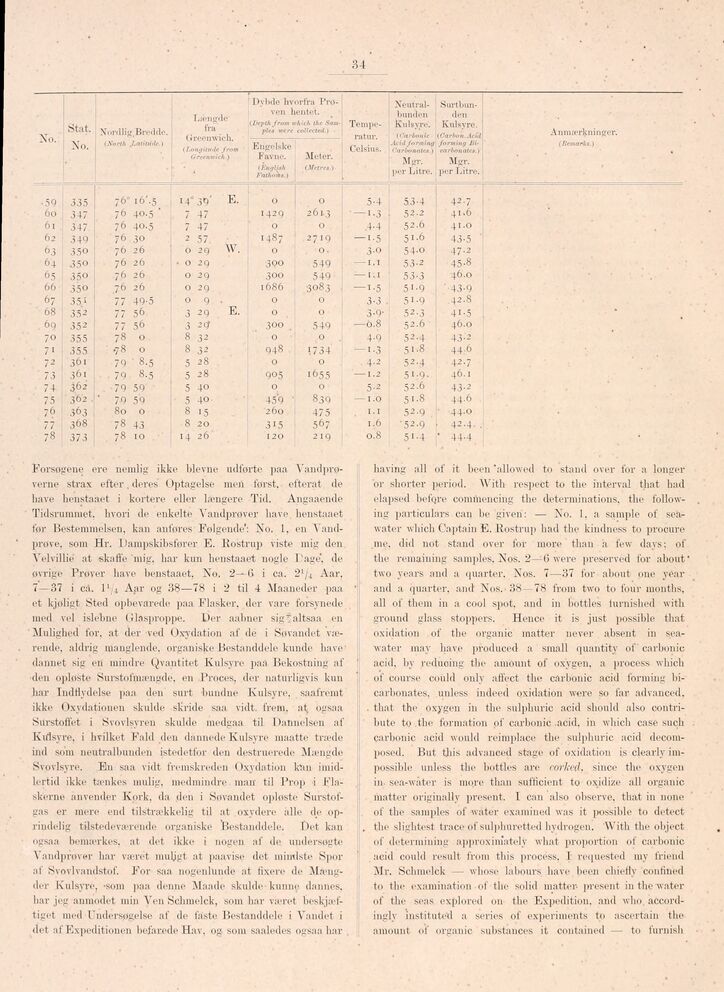
Full resolution (JPEG) - On this page / på denna sida - Sidor ...

<< prev. page << föreg. sida << >> nästa sida >> next page >>
Below is the raw OCR text
from the above scanned image.
Do you see an error? Proofread the page now!
Här nedan syns maskintolkade texten från faksimilbilden ovan.
Ser du något fel? Korrekturläs sidan nu!
This page has never been proofread. / Denna sida har aldrig korrekturlästs.
34
No. Ståt. No. Xordlig.Breddo. lA’oriA J.atitütle.) Længde fra Greenwich. (Longitude from Greenwich.) Dybde hvorfra
Prøven hentet. (Depth from which the
Samples were collected.) Engelske Favne. Meter. (English (Metres.) Fathoms.) 1 [-Temperatur.-] {+Tempe- ratur.+} Celsius. [-Xeulral-1-] {+Xeulral- 1+} lunden Kulsyre. (Carbonic AeiU forming Carbonates.) Mgr. per Litre. Surtbun- den Kulsyre (Carbon.Aci’d .forming
J)i-carbonatcB.) Mgr. per Litre. Anmærkninger. (Remarks.)
■59 335 76° l6’.5 ’4° 39’ E. o 0 5-4 53-4 42-7
60 347 76 4O.5 ’ 7 47 I42Q 261.3 — 1-3 52-2 41.6
6i 347 76 4O.5 7 47 O 0 .4-4 52.6 41.0
62 349 76 30 2 57 I487 27 19 — 1-5 51.6 43-5
63 350 76 26 0 2 g W. O 0 • 3-0 54-0 47.2
64 350 76 26 • 0 29 3PO 549 — 1.1 53-2 45-8
65 350 76 26 0 29 3OO 549 — I.X 53-3 46.0
66 350 76 26 0 29 1686 3083 — 1-5 5’-9 ’ 43-9
67 351 77 49-5 0 9 . 0 0 3-3 . 51-9 .42.8
68 352 77 56 3 29 E. O 0 3-9- 52-3 41-5 *
. 69 352 77 56 3 2g 3OO . 549 —0.8 52.6 46.0
70 355 78 0 8 32 0 0 4-9 52-4 43-2
7i 355 .78 0 8 32 948 1734 — 1-3 51.8 44-6
72 361 79 ’ 8-5 5 28 0 0 4.2 52-4 42-7
73 361 79 8.5 5 28 905 1655 —1.2 51:9 • 46.,
■ 74 362 79 59 5 40 0 0 5-2 52.6 43-2
75 362 ’ 79 59 5 40 459 ’ 839 —1.0 51.8 44-6
76 363 80 0 8 15 260 475 1.1 52.9 ’ 44-0
77 368 78 43 8 20 315 567 1.6 ’52-9 42-4- .
78 373 78 TO 14 26 120 219 0.8 5’-4 ’ 44-4
Forsøgene ere nemlig ikke blevne udførte paa
Vandprøverne strax efter. deres Optagelse meii først, efterat de
have henstå aet i kortere eller længere Tid. Angaaende
Tidsrummet, hvori de enkelte Vandprøver have. henstaaet
før Bestemmelsen, kan anføres Følgende’: No. 1, en
Vandprøve, som Hr. Dampskibsfører E. Rostrup viste mig den
Velvillie at «kaffe mig. har kun henstaaet nogle Dage’, de
øvrige Prøver have henstaaet, No. 2—6 i ca. 2Aar,
7—37 i ca. Vji Aar og 38—78 i 2 til 4 Maaneder paa
et kjøligt Sted opbevarede paa Flasker, der vare forsynede
med vel islebne Glasproppe. Der aabner sig "altsaa en
Mulighed for, at der ved Oxydation af de i Søvandet
værende, aldrig manglende, organiske Bestanddele kunde have
dannet sig en mindre Qvantitet Kulsyre paa Bekostning af
•den opløste Surstofmængde, en Proces, der naturligvis kun
har Indflydelse paa den surt bundne Kulsyre, saafremt
ikke Oxydationen skulde skride saa vidt. frem, at ogsaa
Sürstoffet i Svovlsyren skulde medgaa til Dannelsen af
Ku’lsyre, i hvilket Fald den dannede Kulsyre maatte træde
ind som neutralbuudeii istedetfor den destruerede Mængde
Svovlsyre. En saa vidt fremskreden Oxydation kan
imidlertid ikke tænkes mulig, medmindre man til Prop i
Flaskerne anvender Kork, da den i Søvandet opløste
Surstof-gas er mere end tilstrækkelig til at oxydere alle de
oprindelig tilstedeværende organiske ^Bestanddele. Det kan
ogsaa bemærkes, at det ikke i nogen af de undersøgte
Vandprøver har været niuljgt at paavise det mindste Spor
af Svo vi vandstof. For saa nogenlunde at fixere de
Mængder Kulsyre, -som paa denne Maade skulde kunne dannes,
har jeg anmodet min Ven Schmelck, som har været
beskjæftiget med Undersøgelse af de faste Bestanddele i Vandet i
det af Expeditionen befarede Hav, og som saaledes ogsaa har
having all of it been ’allowed to stand over for a longer
or shorter period. With respect to the interval that had
elapsed befQre commencing the determinations, the
following particulars can be given: — No. 1, a sample of seär
water which Captain E. Rostrup had the kindness to procure
me, did not stand over for more than a few days; of
the remaining samples, Nos. 2—6 were preserved for about’
two years and a quarter. Nos. 7—37 for about one year
and a quarter, and Nos. ’38—78 from two to four months,
all of them in a cool spot, and in bottles furnished with
ground glass stoppers. Hence it is just possible that
oxidation of the organic matter never absent in
sea-water may have produced a small quantity of carbonic
acid, by reduoing the amount of oxygen, a process which
of course could only affect the carbonic acid forming
bicarbonates. unless indeed oxidation were so far advanced.
. that the oxygen in the sulphuric acid should also
contribute to the formation of carbonic acid, in which case such
carbonic acid would reimplace the sulphuric acid
decomposed. But this advanced stage of oxidation is clearly
impossible unless the bottles are corked, since the oxygen
in- sea-wåter is more than sufficient to oxidize all organic
matter originally present. I can also observe, that in none
of the samples of water examined was it possible to detect
the slightest trace of sulphuretted hydrogen. With the object
of determining approximately what proportion of carbonic
acid could result from this process. I requested my friend
Mr. Schmelck — whose labours have been chiefly confined
to the examination • ol’ the solid matter- present in the water
of the seas explored on the Expedition, and who.
accordingly instituted a series of experiments to ascertain the
amount of organic substances it contained — to furnish
<< prev. page << föreg. sida << >> nästa sida >> next page >>